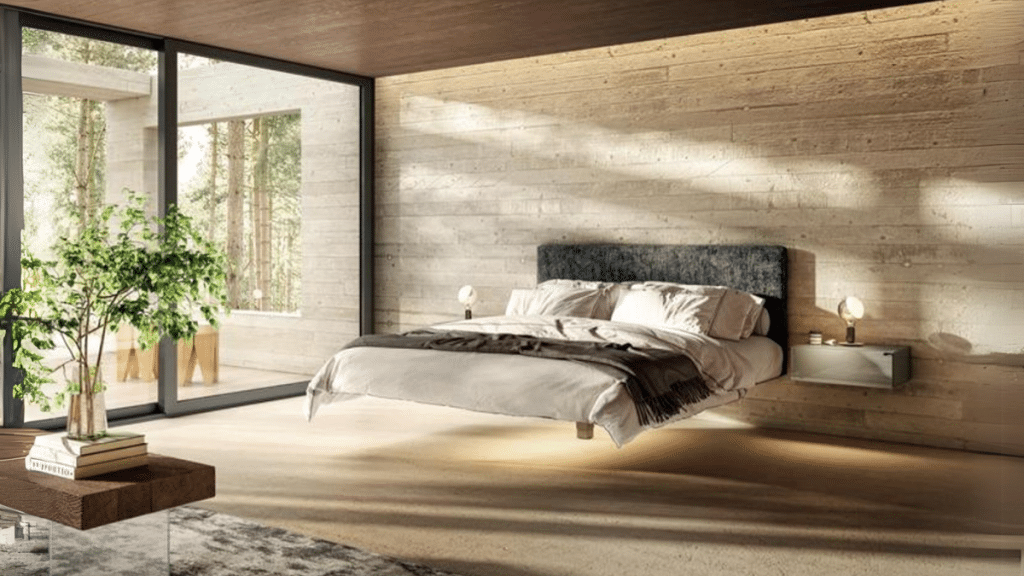Daily well-being is closely linked to the environment in which we live. A well-thought-out interior can promote relaxation, reduce stress, and improve quality of life. Choosing the right furniture is crucial to creating a serene atmosphere where every element contributes to a balance between functionality and aesthetics.
Italian design, known for its timeless elegance and sophisticated approach, plays a key role in creating these calming spaces. By favouring harmonious shapes, noble materials, and thoughtful arrangements, it is possible to transform an interior into a true sanctuary of well-being.
Interior layout: a key to promoting relaxation
The way furniture is arranged in a space directly impacts the perception of well-being. A fluid and airy layout helps create a calming atmosphere, while a cluttered or poorly organised space can generate a sense of oppression. The goal is to design an interior where every element finds its place and the flow remains unobstructed.
Clean lines and organic forms are particularly effective for creating a relaxing ambiance. Inspired by nature, these rounded and soft shapes provide a sense of fluidity and visual comfort.
In a modern dining room, for example, choosing a table with softened edges paired with enveloping chairs helps define the space while maintaining an airy feel. Similarly, a floating bed in the bedroom enhances the sense of openness and serenity by creating an illusion of space and lightness.
Furniture should encourage an intuitive organisation that simplifies daily life without disrupting the overall harmony of the room. Lighting plays a central role in this dynamic: subtly highlighting the furniture and prioritising natural light immediately creates a warmer and more welcoming atmosphere.
Materials and textures: creating a pleasant sensory environment
The experience of well-being in an interior is not only shaped by the arrangement of furniture but also by the materials used to create it. Every surface, every texture, influences how a space is perceived and experienced daily.
Wood, for instance, brings a natural warmth that invites relaxation. Its soft touch and varied hues create calming atmospheres while ensuring the furniture’s timelessness.
Glass plays a crucial role when it comes to optimising brightness and creating a sense of lightness. Used in decorative elements or functional surfaces, it captures light and amplifies it, making spaces feel more open and dynamic.
Its combination with metal, particularly in table legs or storage structures, adds a contemporary touch without compromising the warmth of the overall space.
The harmony of a space also depends on the choice of textures. Alternating matte and glossy finishes, smooth and textured surfaces, enrich the sensory perception and add depth to the environment. This tactile diversity strengthens the impression of comfort and balance, avoiding the overly uniform effect that could make an interior feel impersonal.
Furniture and well-being: combining comfort and aesthetics
Well-designed furniture transforms an interior into a true sanctuary of serenity, where every element contributes to a feeling of harmony and rest. Well-being is achieved not only through physical comfort but also through visual balance and the quality of finishes.
In a living room, a sofa with soft lines and generous proportions invites relaxation, while a coffee table with clean shapes promotes a fluid and calming atmosphere. Every piece should be designed to accompany daily movements without imposing constraints.
The influence of Italian design can be seen in this pursuit of sophisticated comfort, where aesthetics never sacrifice functionality. Balanced proportions and carefully selected materials allow furniture to blend into the space without overwhelming the environment.
The desired effect is one of natural elegance, where the furniture blends into the atmosphere while structuring the volumes. The combination of soft shapes and noble materials creates a calming interior, designed to enhance quality of life and provide a conducive environment for relaxation.
LAGO: furniture solutions with Made in Italy design, combining elegance, refinement, and modernity
Founded in 1976 through the valuable contribution of Giuseppe Lago, LAGO is an Italian company specialising in Made in Italy design, offering elegant and sophisticated furniture solutions. Its range includes an exclusive selection of high-end products, characterised by innovative modular design.
LAGO is built on an innovative vision with roots dating back to the 19th century, anchored in a solid craftsmanship tradition that has always shaped the family’s history. With the arrival of the fourth generation in 2006, the company expanded its horizons and opened to international markets.
Beyond its unique design, LAGO adopted an unconventional communication approach, with a particular emphasis on digital. This evolution was led by Daniele Lago, an entrepreneur who has placed culture at the heart of the company’s strategy.
Today, LAGO relies on a team of highly skilled managers and over 200 employees. Present in more than 20 countries, the company has a network of over 500 selected points of sale, both in Italy and internationally.
The furniture in the collection is designed to integrate harmoniously into every living space and meet the demands of both private and public environments. Characterised by clean lines and refined design, the products are conceived to offer exceptional durability.
Each solution is the result of in-depth aesthetic research and careful studies aimed at ensuring impeccable quality. While industrial processes ensure maximum precision, human intervention remains essential: craftsmanship imparts a unique quality to each creation.
LAGO’s philosophy is based on core values that guide every strategic decision and design choice. Among them, a broad vision of design, seen not only as an aesthetic expression but also as a true lever of social transformation.
Thanks to a continually growing community, LAGO continues to invest in digital innovation to offer an ever-more intuitive and engaging experience. The integration of advanced technologies has optimised web navigation while reducing environmental impact, reflecting the company’s commitment to sustainability.
